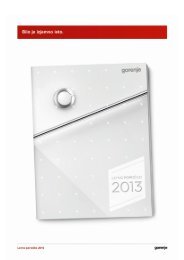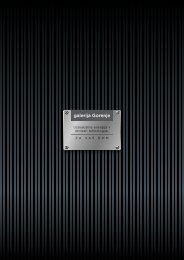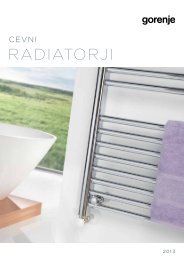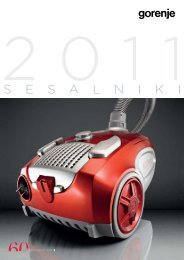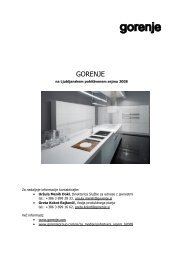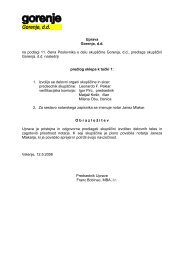ANNUAL REPORT 2008 - Gorenje Group
ANNUAL REPORT 2008 - Gorenje Group
ANNUAL REPORT 2008 - Gorenje Group
You also want an ePaper? Increase the reach of your titles
YUMPU automatically turns print PDFs into web optimized ePapers that Google loves.
144<br />
<strong>2008</strong><br />
Cash flow hedges<br />
Changes in the fair value of the derivative hedging instrument designated as a cash flow hedge are<br />
recognised directly in equity.<br />
If the hedging instrument no longer meets the criteria for hedge accounting, expires or is sold, terminated<br />
or exercised, then hedge accounting is discontinued prospectively. The cumulative gain or<br />
loss previously recognised in equity remains there until the forecast transaction occurs. When the<br />
hedged item is a non-financial asset, the amount recognised in equity is transferred to the carrying<br />
amount of the asset when it is recognised. In other cases the amount recognised in equity is transferred<br />
to profit or loss in the same period that the hedged item affects profit or loss.<br />
Economic hedges<br />
Hedge accounting is not applied to derivative instruments that economically hedge monetary assets<br />
and liabilities denominated in foreign currencies. Changes in the fair value of such derivatives<br />
are recognised in profit or loss as part of foreign currency gains and losses.<br />
(iii) Share capital<br />
Repurchase of share capital (treasury shares)<br />
When share capital recognised as equity is repurchased, the amount of the consideration paid,<br />
which includes directly attributable costs, is net of any tax effects, and is recognised as a deduction<br />
from equity. Repurchased shares are classified as treasury shares and are presented as a deduction<br />
from total equity. When treasury shares are sold or reissued subsequently, the amount received is<br />
recognised as an increase in equity, and the resulting surplus or deficit on the transaction is transferred<br />
to retained earnings or reserves.<br />
Dividends are recognised as a liability on the day of transaction.<br />
(c) Subsidiaries<br />
Investments in equities of subsidiaries are valued at cost. Costs that may be associated with the acquisition<br />
of a subsidiary increase the cost of purchase of the investment in subsidiary. Profit participation<br />
is recognised as income in the period when the Shareholders’ Meeting adopts the resolution<br />
on the dividend payout.<br />
(d) Property, plant and equipment<br />
(i) Recognition and measurement<br />
Property, plant and equipment are measured at cost less accumulated depreciation and accumulated<br />
impairment losses.<br />
Cost includes expenditure that is directly attributable to the acquisition of the asset. The cost of<br />
self-constructed assets includes the cost of materials and direct labour, any other costs directly attributable<br />
to bringing the asset to a working condition for its intended use, and the costs of dismantling<br />
and removing the items and restoring the site on which they are located.<br />
Borrowing costs related to the construction of property are recognised in profit or loss as incurred.<br />
When parts of an item of property, plant and equipment have different useful lives, they are accounted<br />
for as separate items of property, plant and equipment.<br />
Fair value model or revaluation model is applied to land. Revaluation effects are recorded through<br />
equity. Impairment loss of land whose value had previously been increased is directly charged<br />
against revaluation surplus in equity, or else it is recognised in profit or loss. The revaluation of land



